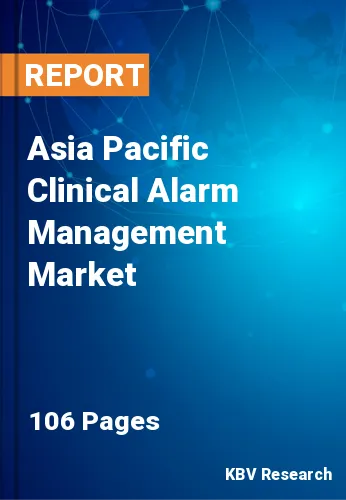The Asia Pacific Clinical Alarm Management Market would witness market growth of 11.2% CAGR during the forecast period (2022-2028).
The majority of the immediate generating of alerts is embodied in the therapeutic practice of alarms. The majority of false positive and non-actionable alarms are lowered or eliminated in clinical practice. Irrespective of the alert notification method employed, this therapeutic practice is essential. The objectives of this therapeutic practice are to reduce false positive and non-actionable alarms, hence reducing the volume of alarms generated. This pillar begins with the patient's appropriate physiological characteristics and monitoring device selection. Although this sounds obvious, there are times when it can be difficult. For instance, a significant portion of telemetry packs is bought for individuals at risk of a clinical condition worsening rather than arrhythmias.
These at-risk patients provide a conundrum because traditional high-acuity units with multi-parameter patient monitors offer a level of care and cost that is above their clinical need while their on-service units frequently lack patient monitors. The telemetry pack has long been used as a compact, portable, and well-tolerated patient monitor for low acuity patients.
Due to rising R&D spending by important national governments to boost the penetration of information technology in the medical area, in this region market has a lot of promise. The resolution of problems with data privacy, user-level authorization, secure storage, data trackability, and other cyber security issues is ensured by a tight legal framework. As part of World Cancer Day, the World Health Organization (WHO) and the International Agency for Research on Cancer (IARC) released two studies. The first focused on setting the agenda for the disease, while the second focused on research and prevention.
In 2018, India's population of 1.35 billion people had 1.16 million new cases of cancer, 784,800 deaths, and 2.26 million 5-year prevalence cases, according to World Cancer Report. The most attractive markets in the region for clinical alarm management are China and India due to their growing elderly populations, patient pools, and healthcare infrastructure. Growing innovations in cutting-edge technology, along with government initiatives that support them, encourage the digitalization of the healthcare industry, which drives the market for clinical alarm management market.
The China market dominated the Asia Pacific Clinical Alarm Management Market by Country in 2021, and would continue to be a dominant market till 2028; thereby, achieving a market value of $456.7 million by 2028. The Japan market is exhibiting a CAGR of 10.6% during (2022 - 2028). Additionally, The India market would experience a CAGR of 12% during (2022 - 2028).
Based on Component, the market is segmented into Solution and Services. Based on End User, the market is segmented into Hospitals, Long-term Care Centers and Ambulatory Care Centers & Home Care Settings Passive CDSS. Based on Product, the market is segmented into Nurse call systems, Physiological Monitors, EMR Integration Systems, Ventilators and Others. Based on countries, the market is segmented into China, Japan, India, Australia, South Korea, Singapore, and Rest of Asia Pacific.
Free Valuable Insights: The Worldwide Clinical Alarm Management Market is Projected to reach USD 5.9 Billion by 2028, at a CAGR of 10.5%
The market research report covers the analysis of key stake holders of the market. Key companies profiled in the report include Koninklijke Philips N.V., General Electric (GE) Co. (GE Healthcare), Ascom Holding AG Spok Holdings, Inc. (Spok, Inc.), Masimo Corporation, Cornell Communications, Inc., Baxter International, Inc., Johnson Controls International PLC, Medtronic PLC, and Vocera Communications, Inc. (Stryker Corporation).
By Component
By End User
By Product
By Country
Our team of dedicated experts can provide you with attractive expansion opportunities for your business.

